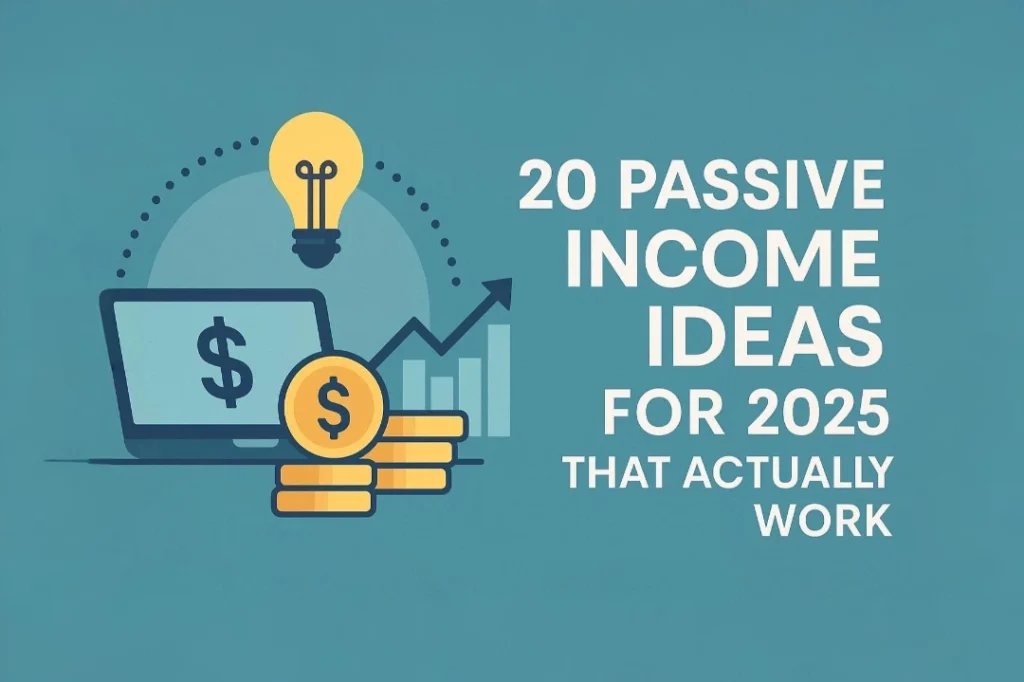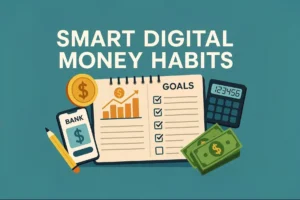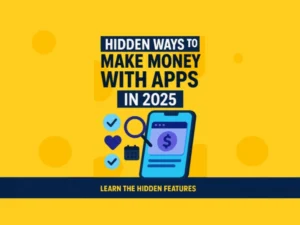20 Passive Income Ideas for 2025 That Actually Work
Let’s be honest—we all dream about making money while we sleep. But those who’ve tried to do it can tell you that not everything so-called “passive income” promises is as promised. Some take much longer. Some just don’t work.
But things are changing fast. With AI tools getting smarter, digital platforms becoming more accessible, and more people working from anywhere than ever before, there’s never been a better time to build income streams that actually earn while you’re offline.
Whether you’re freelancing from a coffee shop, managing your business on the beach, or just trying to make your 9–5 more flexible, this guide breaks down 25 passive income ideas for 2025 that are practical, scalable, and built for today’s digital world.
1. Create and Sell Digital Products
Digital products like eBooks, templates, Notion dashboards, or Canva graphics require work initially but can pay off in the long run. You can automate delivery using platforms like Gumroad and Payhip and focus on marketing.
The greatest advantage of digital products is how well they scale. Having a quality product created, there’s literally no limit to how many times you can resell it. You don’t have to worry about inventory, shipping, or ongoing production expense. For instance, a freelance designer might design an Instagram template pack or a brand kit that can be customized in Canva and resold time and again. Authors can monetize their expertise into specialized guides, checklists, or entire eBooks that earn passive income for years to come.
To succeed in 2025, focus on fixing a specific issue. Digital nomads may need a remote work setup checklist, freelancers may need an invoice tracker, and creators are always looking for better planning systems or productivity boards. Even something as simple as a printable planner or a Notion template for project management can be very lucrative.
Places like Etsy, Creative Market, or even your Shopify store can be supplemented with Gumroad or Payhip in order to put it in front of more eyes. Coupling your product with a blog, email list, or even a simple AI-powered business can get you traffic organically and automate sales completely.
Want to go even further? Bundle products together, offer upsells (e.g., coaching calls or template with extended permissions), or package your product line into a mini-membership or subscription. All of these steps convert one sale into repeat business—without the need to produce new products from scratch each month.
2. Affiliate Marketing
Affiliate marketing remains one of the top passive income streams, especially in 2025 when online trust and niche content mean more than ever. By reselling services, courses, or software that you use and recommend yourself, you can earn commissions whenever someone clicks through your link and purchases something—usually without any extra charge to them.
Affiliate marketing goes hand in hand with blogging, YouTube tutorials, newsletters, and even Facebook statuses. For instance, if you have a productivity blog, you can promote productivity apps like Notion, Todoist, or AI writing assistants, and place affiliate links directly into your review or tutorial articles. StackCommerce and Impact are two platforms that give you access to more than a thousand affiliate programs from SaaS software to online courses and physical products.
The secret to affiliate marketing success is authenticity and relevance of the niche. Don’t promote random deals—only the deals that are relevant to your audience. If you have an audience of freelancers, for example, you can promote FreshBooks or HoneyBook as the perfect software for client management and invoicing.
Lastly, email newsletters have emerged as a lucrative affiliate revenue stream. Platforms such as Beehiiv and Substack simplify the process of building communities and delivering weekly suggestions with affiliate linking. A single product link strategically placed in an email that is actually useful can offset a dozen blog posts combined—particularly when your subscribers value your opinion.
You can also read: How to get High-Paying Freelance Clients in 2025
3. AI-Powered Niche Blogs
Looking to build something once and let it work for you in the background? AI-powered niche blogs are quickly becoming one of the most practical passive income ideas for 2025. With a bit of upfront effort and the right tools, you can launch a blog that drives traffic from Google and brings in money through ads, affiliate links, or even your own digital products—without needing to grind daily.
It all starts with choosing a niche you’re either interested in or one that shows strong SEO potential. Don’t just go for the usual stuff. Think about emerging spaces like AI tools for remote workers, digital nomad hacks, or minimalist fitness. Once you’ve picked your angle, use tools like Jasper or Copy.ai to help brainstorm ideas and draft blog content. Then plug your drafts into Surfer SEO to optimize them and give your site a better shot at ranking on Google.
After publishing a few solid posts, you can begin monetizing. Display ads from networks like Ezoic or Mediavine are a great way to earn from page views. You can also drop in affiliate links where relevant. For example, if you’re reviewing productivity tools, it’s natural to link to your own post AI Extensions for Freelancers 2025. That kind of internal linking adds value and helps with SEO too.
What’s great about blogging is its longevity. Unlike Instagram reels or TikToks that fade within hours, a well-written blog post can stay relevant and keep earning for years. To make this work, stay consistent. Post regularly, update your older content, and link your articles together. You can even batch-create content with AI, then do a quick human edit to keep your tone natural and authentic.
If you enjoy the process, scale it. Start a second or third blog in different niches. You can outsource editing or SEO if you want to grow faster. Over time, you’ll build a portfolio of blogs—each earning quietly in the background while you focus on bigger projects or just enjoy more free time. Pair your blogs with a newsletter, and you’ve got a truly automated system working for you.
4. Online Courses & Coaching
Got a talent you’re good at? Maybe it’s graphic design, writing, coding, or taming messy schedules. Or more likely, someone somewhere wants to know your secret. That’s where online courses and coaching come in—they enable you to turn your knowledge into a viable income stream with surprisingly little work after the initial setup.
You don’t need to be some sort of technical genius to get started. Sites like Udemy, Teachable, and Kajabi do all the behind-the-scenes stuff—like hosting your course, managing payment processing, and even automated enrollments. Your job? Create content once and then let it pay for itself while you sleep.
If you already have engagement on platforms such as LinkedIn, YouTube, or even TikTok, you’re in good shape. The people already following your free advice are more likely to pay for your longer-term guidance. If you post quick freelance advice on TikTok—why not point to a course that dives deeper into client prospecting or increasing freelance income?
Not quite there for a full course yet? That’s totally fine. Begin with small group or 1-on-1 coaching first. It’s a great means of testing what folks actually want, getting testimonials, and gaining confidence. You can then turn those sessions into a polished course later down the line. It’s a brilliant switch from active income to passive income—and it scales fabulously.
Want to make your course even more irresistible? Include helpful bonuses like templates, checklists, or bonus mini-lessons. People love receiving more than what they’re paying for. And don’t forget about upselling—if a customer purchases a beginner’s course, they might want advanced coaching or other products you create as well.
Pair this plan with your evergreen content like your newsletter or blog. Suppose someone’s reading your guide on how to scale a freelancer business, then offering a course on the exact same topic makes perfect sense. It’s a natural next step—and that’s the way you build an income machine.
5. Invest in Dividend Stocks
Want to get paid just for having something? That’s dividend stocks—and believe me, it is a thing. When you invest in stocks that distribute their earnings to investors on a regular basis (in the form of dividends), you’re essentially building yourself a paycheck that gets deposited into your account without ever having to work.
Here’s how it works: Let’s say you invest in stock of a solid company like Coca-Cola or Johnson & Johnson. They send you a portion of their profits on a quarterly basis (or sometimes monthly) for owning shares. It may be a tiny bit at first—say a few dollars at a time—but payments can add up fast, especially if you put them back into more shares.
That is where the magic of compounding takes place. If you reinvest your dividends, you are buying more shares that pay you more dividends, which buy more shares… and so forth. It is like planting a money tree and watering it monthly.
You don’t need to be a Wall Street wizard to get started, either. Platforms like Fidelity, Robinhood, or M1 Finance make it absolutely easy to open up an account and get started investing, even with little money. Some of them offer fractional shares, so you can own $10 worth of Apple or Microsoft without needing to buy a full share.
And the great thing about it—is dividend investing not very time-intensive. Once you’ve researched, picked your stocks (or purchased a dividend-focused ETF), you can let the plan run in the background as you live. It’s a “set it and semi-forget it” style of plan that rewards patience.
Of course, like any investment, there are risks—markets ebb and flow. But if you hold onto good, stable companies with a track record of paying steady dividends, it can be one of the most reliable sources of passive income out there.
Pro tip: If you’re just starting out, go check out websites like Dividend.com or Dividend Growth Investor to learn how you can build a smart dividend portfolio to suit your goals.
6. Real Estate Crowdfunding
Imagine this: profiting from real estate without having to worry about tenants, repair claims, or huge down payments. This is the real estate crowdfunding magic. Platforms like Fundrise and RealtyMogul enable you to invest in multi-million dollar real estate transactions—such as office buildings or apartment buildings—without ever becoming a landlord.
Here’s the good news: it costs you to make an investment and invest alongside other investors in buying into real estate opportunities. Your profit is a slice of the rental income and potential growth. Most platforms pay dividends on a monthly or quarterly schedule, and it’s all viewable from your dashboard. It’s real estate investing without the headaches—whether you’ve ever owned property or not.
Don’t worry if you are not a property expert. These sites do everything for you—from choosing properties to managing them—so you only need to select an investment plan according to your goal. If you want regular income or appreciation in the long run, there is usually a plan for it.
Real estate crowdfunding is ideal for anyone who wants to diversify income streams without placing all their eggs in the stock basket. It’s especially great for remote workers and digital nomads who want to gain passive income that will not make them need to stay fixed in a spot. Just be sure to read the fine print and understand the risks—there’s no promise of returns, and your money may be tied up for a couple of years depending on the investment.
7. License Your Photography or Art
Got an eye for visuals? Whether it’s photography, illustrations, or digital art, your creative work could be earning you passive income around the clock. Platforms like Shutterstock and Adobe Stock let you upload your creations and get paid royalties every time someone downloads them.
And the best part is, you don’t necessarily have to be some kind of world-famous artist or professional photographer. You just need stuff that people would want to use—business icons, lifestyle photos, tech sketches, or even bizarre patterns. Once it’s posted, your creation can keep bringing in money for months or even years to come, with no additional effort from you.
Think of it in terms of this: every picture or graphic is a tiny digital file. The more you offer, the bigger your portfolio—and the bigger your potential to earn money. Some artists make hundreds (or thousands) of dollars per month doing it in this manner. It starts off small, but keeping it regular is the key.
Want to increase your potential earnings? Investigate trend topics or gaps in existing libraries. For example, remote work visuals, productivity graphics, or representation of people in stock images are always in demand. Make sure your uploads are high quality, well-tagged, and easy to find.
Over time, your creative work can be a passive income stream. You simply need to post what you already like to do—and let the sites take care of the rest.
8. Sell Print-on-Demand Products
If you’ve got a creative side—or even just a funny idea—there’s money to be made in the world of print-on-demand. You can design t-shirts, mugs, tote bags, hoodies, phone cases, and more, all without ever touching a single piece of inventory. Thanks to platforms like Printful and Teespring (now Spring), the entire process can be automated.
Here’s how it works: you create a design (you don’t have to be a graphic designer—tools like Canva work great), upload it to your shop, and link it to your store or marketplace. When a customer places an order, the website prints it, ships it, and provides customer service. You just earn the profit margin.
The best of all is that you don’t lose money buying in bulk or getting left with inventory. It’s a low-barrier way of having a side business. And if you tie your store to a niche—like remote workers, digital nomads, or AI lovers—you’ll stand out from the crowd.
While it’s not “get-rich-quick,” a well-positioned product with good SEO and some social media traction can start bringing in passive sales. Add in holidays, trend spikes, or viral moments, and your store can earn while you sleep.
9. Monetize a YouTube Channel
Creating a YouTube channel isn’t just about getting views—it can become one of the most rewarding passive income sources out there. Once you hit the platform’s monetization requirements (1,000 subscribers and 4,000 watch hours in the past year), you can start earning money from ad revenue.
But it doesn’t stop at ads. Most creators actually earn more from affiliate marketing, selling digital products, or offering online courses than from YouTube ads alone. That’s because you’re building an audience that trusts you—and when they trust you, they listen to your recommendations.
Let’s say you’re into productivity hacks. You could review AI tools, share freelance tips, or talk about your remote work setup. Add affiliate links in the description, promote your downloadable templates, or offer a mini-course. Each video becomes a digital asset that earns over time, especially if it ranks on search.
Yes, making videos takes upfront work, but the rewards compound over time. Some creators earn income from videos they uploaded years ago. That’s the magic of evergreen content.
And don’t worry—you don’t need fancy gear to get started. A decent phone, a good mic, and clear value for your audience can take you far. Authenticity wins.
10. Rent Out Digital Assets
If you’ve built a valuable digital property—like a blog, niche website, mobile app, or even a premium domain name—you might be sitting on a passive income goldmine. Renting out these digital assets is an underrated way to earn consistently without daily effort.
Think of it as virtual property. Just as a landlord rents out apartments, you can rent out space on your site for advertisements, rent an application to a company, or sell leads generated off your site. You’ve already done the heavy lifting—now get that asset to work for you.
For example, if you own a well-read blog that features AI applications, a business in the same sector can pay to put their products or website URLs on your site every month. Or if you own a clean, keyworded domain name, someone can lease it while they build a reputation for themselves.
Want proof this works? Visit marketplaces like Flippa, where people buy, sell, and rent out digital assets every day—sometimes for thousands of dollars a month. It’s a thriving economy most people never think about.
Renting digital assets is ideal if you’re ready to step back from active content creation but still want steady income. If your digital footprint has value, others will pay to use it.
11. Write and Sell eBooks
Got a unique perspective or specialized knowledge from freelancing, remote work, or just life experience? You don’t need a publishing deal to become an author anymore. Platforms like Amazon KDP and Gumroad make it incredibly easy to write, format, and sell your own eBooks—no agent, no warehouse, and no inventory required.
This is one of the smartest passive income ideas for 2025 because you do the work once—then keep earning for years. Whether it’s a “how-to” guide on freelancing platforms, a niche productivity system, or even a collection of short stories, your writing can reach global audiences while you sleep.
Pro tip: combine your writing with your own audience—like your blog, email list, or social media followers—for even better results. A few sales per week can stack up fast, especially if you create a series or bundle.
12. License Music or Sound Effects
If you’re musically inclined or have a knack for audio design, you could be sitting on an untapped goldmine. Composers, beatmakers, and even amateur sound designers are making consistent income by uploading their original audio content to licensing platforms like Epidemic Sound, Pond5, or AudioJungle.
The concept is this: You create and upload your tracks or effects. Then, every time someone downloads or licenses your content—whether it’s a YouTuber, director, or advertiser—you receive royalties. You can even charge at different levels depending on the usage rights.
Among the creative passive income ideas for 2025, licensing your music stands out because of its longevity. A single 30-second ambient loop or bass-heavy beat could bring in revenue for years to come, especially if it finds its way into commercial projects.
13. Invest in REITs
Interested in generating real estate income without ever being a landlord? That’s where REITs—Real Estate Investment Trusts—step in. They are firms that own or finance income-producing properties, and they pay out a share of their profit to investors in the form of dividends.
You can now own a piece of everything from data centers to apartment buildings and malls with a brokerage account and a few clicks. ETFs like VNQ give exposure to a few dozen REITs in one wrapper, and it is easy to get diversified without needing to pick individual stocks.
This is one of the most time-efficient passive income ideas for 2025—you’re simply collecting rent checks (in the form of dividends) without ever touching a toilet or answering a tenant’s midnight call. Just make sure to review performance, fees, and dividend history before investing.
14. Mobile App Monetization
Think you need to be a hardcore coder to make money from mobile apps? Think again. In 2025, even non-coders are entering the app battle with tools like BuildFire, Glide, or Adalo. These platforms allow you to build vanilla-vanilla, functional apps without ever writing a single line of code.
Once your app is live—maybe it’s a daily planner, a fitness application, or even a wacky soundboard—you can start making money off of banner ads, in-app purchases, or paid upgrades. The charm here is scalability: develop once, distribute on iOS and Android, and every download could be worth dollars.
Even developers buy failing apps, give them a little spruce up, and relaunch them. Whether you’re launching from square one or reselling apps, mobile app monetization has become one of the most creative passive income ideas for 2025—especially for those who have a knack for experimenting with tech and trends.
15. Cashback & Reward Apps
This one won’t make you rich overnight—but hey, it’s literally free money. Cashback and reward apps are one of those easy wins that most people overlook. Whether you’re buying groceries, ordering food delivery, or booking a hotel, platforms like Rakuten, Honey, or Pei quietly help you earn back a slice of what you already spend.
It’s not passive income for early retirees—but save it up over time, and it starts to pay dividends. Some users are reportedly making hundreds of dollars a year through simply clicking an extra button or activating an offer before buying.
If you’re exploring beginner-friendly passive income ideas for 2025, this is a no-brainer. Install a few browser extensions or mobile apps, shop as usual, and collect those micro-wins. Then, redirect those earnings into something bigger—like stocks, crypto, or your own side hustle.
16. Crypto Staking
Crypto staking might sound like something only hardcore blockchain enthusiasts do—but it’s becoming one of the more accessible passive income ideas for 2025. And no, you don’t have to be a tech genius or stare at charts all day to make it work.
In its most basic terms, staking is basically earning interest on your hoard—but instead of stashing cash in a bank, you’re placing your crypto in a blockchain network. When you “stake” coins like Ethereum (ETH), Cardano (ADA), or Solana (SOL), you’re really putting in the effort that keeps the network going—like securing transactions—and as a reward, you get paid in the form of crypto, which accumulates in your balance over time.
Let’s say you have a few hundred dollars’ worth of ADA. Instead of it collecting dust in your wallet, you stake it through a service like Kraken or Coinbase. Your coins stay in your control, but you start earning tiny daily or weekly dividends—sometimes up to 5–10% annually, depending on the token and market.
The best is that once you have it installed, there is not much to do. No trading, charting, or market timing. You just stake your coins in a staking pool and let the system handle the rest.
Of course, crypto does come with risks—like price volatility and platform reliability—so it’s smart to stick with trusted exchanges and never stake more than you’re comfortable holding long-term. But for those willing to wet their feet in the world of digital assets and make money in the process, staking is a powerful passive tool.
And as the cryptocurrency world continues to grow up in 2025, staking is no longer a pastime for early adopters—it’s a savvy and rapidly growing mainstream passive investment strategy.
17. Peer-to-Peer Lending
If you ever wished to be the bank, peer-to-peer lending gives you that chance—without the need for a cash vault. Using websites like LendingClub or Prosper, you can lend your money to individuals or small companies and earn interest as they pay you back.
It’s a hands-off way of allowing your money to accumulate over time. You simply invest in loans in small chunks—sometimes as little as $25 per note—and the website spreads your money across numerous borrowers. As the payments are made monthly, you’re paid your portion of the interest.
Of course, like all investments, there is a little bit of risk. Not all loans will be paid back. But if you diversify the lending portfolio and reinvest your proceeds, the strategy can be a stable cash flow. It’s a low-profile strategy that slots well into the broader universe of passive income ideas for 2025, especially for individuals who want to accumulate wealth without having to work with tenants or stock.
18. Create a Paid Newsletter
Email might feel old-school, but it’s still one of the most powerful ways to build and monetize a loyal audience. Platforms like Substack and Beehiiv make it incredibly easy to launch your own paid newsletter—even if you’re starting from scratch.
If you’ve got deep knowledge in a niche—whether it’s remote work, design, finance, or even AI tools—you can write once a week and charge subscribers to get exclusive insights, tips, or updates. Think of it like building your own mini-media business.
What makes newsletters so appealing is the low overhead and personal connection. You own your audience. And if you already have followers on LinkedIn, X (formerly Twitter), or YouTube, you can funnel them into your newsletter funnel.
It won’t be 100% passive at first—you’ll need to show up consistently—but once you build momentum, paid subscriptions can keep generating income long after the heavy lifting is done.
19. Sell AI Prompts or Templates
As AI tools become more popular in 2025, there will be a significant demand for pre-made prompts, workflow templates, and automation tools. If you have ever produced a breathtaking Midjourney scene or an incredible ChatGPT prompt, there is someone out there who would be delighted to pay for your labor.
Resources like PromptBase allow you to upload your most successful AI prompts and resell them to other creators, marketers, developers, or content writers. The same is true for Notion templates, Zapier flows, or Canva designs. If you’ve developed something valuable, scalable, and repeatable—you have a digital product.
The brilliance of this method is you only do it once and sell it a million times. And since it’s digital, there is no shipping, no inventory, no customer service headaches. One of the least hands-on methods of making money in the AI economy, and particularly ideal for freelancers and solo entrepreneurs.
20. Remote Property Management
Managing rental properties used to mean being physically nearby—or hiring someone who was. But thanks to modern platforms like Avail and Guesty, you can now run a rental business from anywhere in the world.
These tools let you automate everything: listings, guest communication, payments, maintenance coordination, and even cleaning schedules. Whether you’re managing a long-term apartment or a vacation rental on Airbnb, remote management means you’re not tied to one location.
This is especially attractive if you already own property or are planning to invest. With effective systems in place, you can keep your time investment minimal and still earn regular monthly income. Throw in automation tools and you have a real estate strategy that won’t take away your freedom.
For digital nomads or remote-first entrepreneurs, it’s a smart way of income diversification without being bound to a specific location—or career.
Final Thoughts
To build long-term passive income, you need to have a plan, be patient, and be willing to try new things. But as the tools get better and easier to use, more people can become financially free. These passive income ideas for 2025 can help you work smarter, not harder, and make more money in different ways for years to come.
Explore more money-making strategies in these posts:
- Get Paid Faster as a Freelancer in 2025
- Money-Saving Tips for Freelancers in 2025
- Hidden Features in Money-Making Apps
Ready to build your income stack? Subscribe to our newsletter and get weekly tips, tools, and guides delivered to your inbox.





